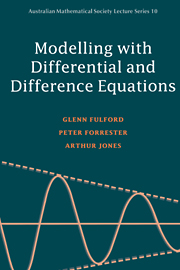Book contents
- Frontmatter
- Contents
- Preface
- Introduction to the student
- Part One Simple Models in Mechanics
- 1 Newtonian mechanics
- 2 Kinematics on a line
- 3 Ropes and pulleys
- 4 Friction
- 5 Differential equations: linearity and SHM
- 6 Springs and oscillations
- Part Two Models with Difference Equations
- Part Three Models with Differential Equations
- Part Four Further Mechanics
- Part Five Coupled Models
- References
- Index
3 - Ropes and pulleys
Published online by Cambridge University Press: 05 June 2012
- Frontmatter
- Contents
- Preface
- Introduction to the student
- Part One Simple Models in Mechanics
- 1 Newtonian mechanics
- 2 Kinematics on a line
- 3 Ropes and pulleys
- 4 Friction
- 5 Differential equations: linearity and SHM
- 6 Springs and oscillations
- Part Two Models with Difference Equations
- Part Three Models with Differential Equations
- Part Four Further Mechanics
- Part Five Coupled Models
- References
- Index
Summary
This chapter is about mechanical systems in which particles are attached to a rope which passes around some pulleys. To keep the mathematical model simple, we shall ignore friction, together with the masses of the rope and the pulleys. Newton's laws can then be used to find the tension in the rope and the acceleration of the particles.
On the basis of this mathematical model, it is possible to explain the operation of the ‘block and tackle’, which is often used in factories to raise heavy loads. It will be shown how a small force exerted by a workman pulling on one end of a rope can be converted by the pulleys into a large force acting on the heavy load.
The mathematical model also provides the theory underlying Atwood's machine, a contraption which is sometimes used to measure the acceleration due to gravity.
The main skill which this chapter aims to develop is that of using Newton's laws to derive equations of motion. The chapter also provides incidental practice at solving systems of simultaneous linear equations, solving differential equations by antidifferentiation, and manipulation of inequalities.
First, however, a model will be constructed for the forces acting in the rope.
Tension in the rope
The dynamical role of a piece of rope may be illustrated by what happens in a tug of war. By pulling on the rope, one team is able to exert a force on the other team, even though the teams are some distance apart.
- Type
- Chapter
- Information
- Modelling with Differential and Difference Equations , pp. 41 - 59Publisher: Cambridge University PressPrint publication year: 1997

